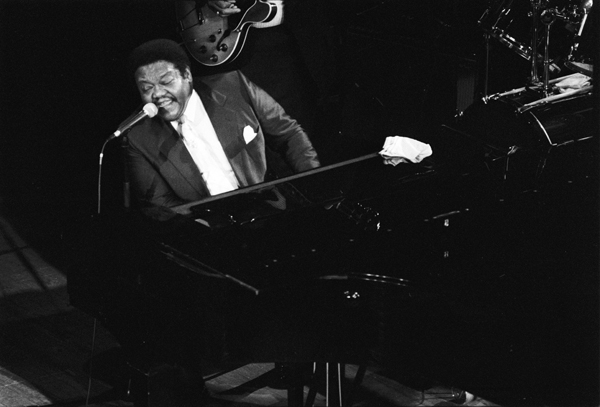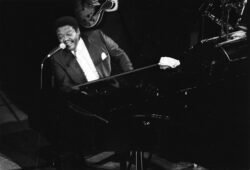Blues Music
Of the 119 musicians inducted into the national Blues Hall of Fame, roughly twenty percent are from Louisiana.

Public Domain.
Reproduction of a black-and-white photograph of Fats Domino performing in Normandy, France, in 1992.
Louisiana is well known for its contributions to jazz, Cajun music, and zydeco, but the state’s blues legacy is sometimes overlooked. Of the 119 musicians inducted into the national Blues Hall of Fame, roughly twenty percent are from Louisiana. Among them are Irma Thomas, Ferdinand “Jelly Roll” Morton, Huddie “Lead Belly” Ledbetter, Antoine “Fats” Domino, Walter “Little Walter” Jacobs, George “Buddy” Guy, and Henry Roeland Byrd, better known as “Professor Longhair.” Traditionally associated with African American work songs and field hollers, the blues have evolved over time—like all musical genres—making it difficult to identify qualities or elements common to all blues songs, past and present. Often the blues focus on everyday events ranging from mean bosses to romantic relationships gone awry, and the music generally interacts with, rather than simply accompanies, the vocals—frequently in a call-and-response pattern. Even within Louisiana, however, the term “the blues” encompasses a tremendous variety of sounds and styles.
Shreveport’s Cultural Crossroads
In the state’s northwestern corner, Shreveport played an important role in the development of the blues during the first half of the twentieth century and after World War II. In the early part of the century, Shreveport was an important center for the development of a largely urban style of guitar-based blues that emphasized lively rhythms and nimble finger picking. Though today he is regarded more as a folk singer than a blues musician, “Lead Belly” studied guitar with, and was influenced by, Texas bluesman Blind Lemon Jefferson. While serving time in the Louisiana State Penitentiary at Angola, Lead Belly was “discovered” by folklorist John Lomax and his son, Alan, in 1933; after his release, they helped record and popularize his music, giving many Americans their first taste of the blues.
Following World War II, numerous musicians recorded in Shreveport at the KWKH radio studio as well as in the studios of independent record labels, such as the Jewel-Paula-Ron family of labels run by Stan Lewis, a record-store proprietor. Lewis achieved national prominence recording songs by established blues musicians such as Willie Dixon, Big Joe Turner, and John Lee Hooker as well as rockabilly pioneer Dale Hawkins, zydeco virtuoso Clifton Chenier, and swamp-blues diva Katie Webster.
Baton Rouge Blues
Another group of musicians launched their careers from Baton Rouge and its environs, where they created the distinctive post−World War II Louisiana style known as swamp blues. Jimmy Reed, probably the best-known musician of this style, blended the instrumental virtuosity of urban blues with a more relaxed, rural sound. The result was a hybrid that appealed to rhythm-and-blues (R&B) fans, including The Rolling Stones, whose first few albums displayed an allegiance to swamp blues pioneers. Jay Miller’s recording studio in Crowley, twenty miles west of Lafayette, played a central role in the development of the genre. James “Slim Harpo” Moore, Leslie “Lazy Lester” Johnson, and Otis “Lightnin’ Slim” Hicks were among the Baton Rouge–based musicians who recorded swamp blues for Miller’s Excello record label. Slim Harpo, in particular, had a series of influential hits, beginning in the late 1950s with “I’m a King Bee” (1957) and continuing through “Rainin’ in My Heart” (1964) and “Scratch My Back” (1966).
Another Baton Rouge native, Ernest “Tabby” Thomas, had a major hit with the 1962 single “Hoodoo Party,” now recognized as a landmark recording in the swamp blues genre. Unable to capitalize on the record’s commercial success, Thomas worked in construction and manufacturing until the late 1970s. In 1980 he opened his own nightclub, Tabby’s Blues Box, which soon became the center of the Baton Rouge blues scene. In recent years, Thomas’s son, Chris Thomas King, has worked to make traditional blues relevant to a new generation. In 1995 he released 21st Century Blues … From Da Hood, which mixed elements of blues, rap, and hip-hop. Similarly, his 2000 album Me, My Guitar and the Blues artfully combined hip-hop, soul, and country blues. An appearance in the 2000 film O Brother, Where Art Thou? drew additional attention to his music and helped Thomas launch an acting career.
Though not associated with the swamp-blues style, another important blues musician called Baton Rouge home—at least for a while. Born in the Lettsworth community of Pointe Coupee Parish, Buddy Guy moved to the capital city as a teenager. In the 1950s Baton Rouge blues musician and club owner John “Big Poppa” Tilley gave Guy his first gig but then fired him when the intimidated musician played with his back to the audience. Guy recovered from his stage fright, relocated, and went on to help pioneer a distinctive style known as Chicago blues. Pianist Henry Gray, who grew up in Baton Rouge and sometimes played with Guy, also helped shape the Chicago blues piano style while playing with Howlin’ Wolf’s band in the 1950s.
New Orleans’s Musical Melting Pot
New Orleans’s blues heritage encompasses two related traditions: small-band, jazz-based blues and piano “professors” who delighted audiences with their combination of artistry and showmanship. Both traditions trace their origins to the turn of the twentieth century, when solo pianists could earn good money by playing in labor camps, informal drinking establishments, and legalized houses of prostitution in Storyville. As the century progressed, New Orleans pianists absorbed the newer boogie-woogie and stride piano styles while remaining faithful to the Spanish and French influences that filtered into the city through the Caribbean. These styles flavored early R&B and rock ’n’ roll with relaxed tempos and strong, syncopated rhythmic patterns that came to be known as the New Orleans “sound.”
At the same time, traveling medicine shows, vaudeville, and neighborhood dance halls fostered a small-band tradition that shaped early jazz. In fact, early blues and early jazz were so thoroughly intertwined in New Orleans that in many cases it was impossible to tease them apart. Among the earliest jazz musicians, for instance, Jelly Roll Morton stands apart as a pianist and composer who translated his affinity for the blues into formal compositions and arrangements while at the same time maintaining an affection for a more basic piano and vocal blues style throughout his career. As a result, Morton left a legacy of compositions that have become standards of the repertoire, such as “Winin’ Boy,” “Don’t You Leave Me Here,” and “I Thought I Heard Buddy Bolden Say.”
During this same era, blues pioneer Gertrude “Ma” Rainey frequently wintered in New Orleans, where she got to know such jazz pioneers as Joe “King” Oliver, Louis Armstrong, and Sidney Bechet. As blues and jazz gradually made their way into mainstream American culture during the swing era, the singer and guitarist known as Lizzie “Memphis Minnie” Douglas stands out as a trailblazer. (Despite her nickname, Douglas was born in the Algiers section of New Orleans.) One of the first musicians in any genre to embrace the electric guitar, Memphis Minnie helped lead the transition from acoustic rural blues to electrified urban blues in the early 1940s.
Around World War II, small ensembles played a new style based on upbeat rhythms and compact arrangements. Often they featured fresh sounds, such as “honking” saxophones and witty lyrics seasoned with the latest “hip” vernacular. Inspired by bandleaders such as Louis Jordan, this jump blues style was a forerunner of R&B and rock ‘n’ roll. In 1948 blues singer Roy Brown released “Good Rocking Tonight,” an R&B hit that combined jazz-flavored jump blues with a more emotional singing style rooted in black gospel music.
Meanwhile, Fats Domino forged a new piano style, a gently rolling sound that was based on the New Orleans barrelhouse tradition and that utilized the piano triplet and a heavy bass line. He went on, of course, to become a renowned pioneer of rock ‘n’ roll. During the 1970s, another pianist, Professor Longhair, achieved cult status with his idiosyncratic piano style, which blended Latin syncopation with a boogie-woogie rhythm. New Orleans musician, singer, and guitarist Eddie “Guitar Slim” Jones also left an enduring legacy with his 1954 hit, “The Things I Used to Do,” which featured a young Ray Charles as pianist and arranger. Guitar Slim had a wildly flamboyant performance style and used an amplified distortion to explore the range of the electric guitar.
In more recent years, pianist Henry Butler has given new meaning to the adjective “eclectic,” demonstrating a mastery of ragtime, jazz, blues, funk, and gospel, occasionally rendered in a rapid-fire, seamless introduction to a more formal composition. Blind since birth, Butler continues to push musical boundaries, playing Broadway show tunes as mournful blues and rock music as ominous soul.
Irma Thomas, known as the “Soul Queen of New Orleans,” released her first record in 1960; forty-seven years later, she won the Grammy for Best Contemporary Blues Album for After the Rain. Early in her career, Thomas saw two of her most promising numbers become big hits for other artists: Otis Redding recorded “Ruler of My Heart” (and renamed it “Pain in My Heart”), and The Rolling Stones had a hit with “Time Is on My Side.” To Thomas’s dismay, the latter song was copied note-for-note, word-for-word—including Thomas’s spoken interlude—and she refused to perform the song again until the 1990s.
Other Louisiana Blues Musicians
The blues originated in rural areas and small towns, of course, and musicians from less populated parts of Louisiana also contributed to the state’s blues heritage. Beginning in the late 1940s, Alexandria native Little Walter explored ways to combine blues harmonica with electric amplification, cupping a harmonica and microphone in his hands while playing. In addition to fourteen of his own Top 10 R&B hits between 1952 and 1958, Little Walter helped inspire Muddy Waters’s classic Chicago blues.
In the southwestern prairies, zydeco music merged contemporary R&B with Francophone musical traditions, such as “la la” and Cajun music. Zydeco pioneer Clifton Chenier pointed to the connection himself when he titled his first hit “Clifton’s Blues.” Chenier often employed Louisiana blues guitarists as backup musicians (notably Phillip Walker and Paul “Li’l Buck” Sinegal) and frequently appeared at regional and national blues festivals during the 1960s and 1970s. Meanwhile, from Ferriday, singer and pianist Jerry Lee Lewis brought together strands of gospel, blues, and country music in groundbreaking rockabilly recordings.
Louisiana blues musicians from all parts of the state have influenced internationally celebrated artists such as Janis Joplin, Jimi Hendrix, Eric Clapton, and The Rolling Stones. While Mississippi is more commonly associated with the genre, musicians from the other side of the Delta also contributed to the region’s blues heritage.
